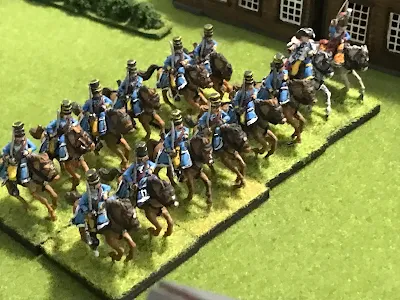On the blog "Battlefields and Warriors", Norm has devised a wonderful multi period scenario. It is designed for a smaller table (6 x 4) and modest forces. Most importantly to me is the ability to place it in any time period, with adjusted forces to reflect that time. It is an interesting tactical problem which should make a most interesting game. Reminds me greatly of the old Table Top Teasers from Military Modeling in my younger days That’s the 1970’s to you, by the way These were always the first pages I turned to and read. They always greatly inspired me and influenced my gaming and hobby.
I plan on fighting this out on the table top with American Rev War, War of 1812 and Crimean War armies. I will make some adjustments to the forces to better keep within the time period I am playing. So stay tuned for three battles.
Thank you Norm for sharing this!
http://battlefieldswarriors.blogspot.com/2022/11/generic-multi-period-scenario-creation.html
Here is the game plan from Norms blog.
From Battlefields and Warriors blog:
Multi period
Forces:
At start, both sides have the same units, these being;
5 x regular infantry units
1 x elite infantry unit
1 x medium cavalry unit
1 x foot battery
2 x average commanders so that 2 commanded formations can be formed PLUS 1 x average commander to work with the reinforcement
Optional rules for forces:
At the start of play, each player rolls a D6. 1-2 the player loses one of their regular infantry units. 3-4 no effect. 5-6 the player gains an additional regular infantry unit OR can upgrade any one (only) existing unit to elite status.
Admin :
All units except one, start the game by being set up anywhere along their baseline and up to 4” in from the edge. See special rules for the one unit that does not begin play on the table.
The game will end the moment one of the forces loses 50% of their units. At that time check to see which player controls the bridge (defined below) to establish a winner.
Special Rules:
The river is only cross-able via the bridge In a modern setting, amphibious capable vehicles cannot be used to cross the water.
The ditch counts as a linear obstacle and provides cover when attacked frontally.
One unit from each side will not be set-up on the table at start. That unit is off table manoeuvring on the flank. Starting on turn 2 and on each subsequent turn, at the start of their turn, a player will roll a D6 on and a score less than the current turn number, their reinforcement will arrive along either of the short edges of the table.
The player chooses which end of the table the unit will come on and at what point, so it can arrive on the enemy flank or the player might prefer it to arrive on their own flank as a reinforcement to shore up their own position. The reinforcement is given its own commander, who will be of average quality.
The armies will set up on their baseline (one of the wide table edges) and before play, both players will each roll a D6 adding +1 if they have chosen elite cavalry. The winner chooses which of the two table edges they will play from. Re-roll equal modified scores.
Winning :
This is a meeting engagement and victory will be based upon the capture of the bridge. Once the game is called, based on a side suffering 50% casualties, check who controls the bridge. Controlling both ends of the bridge (i.e. the road bit at each end) will be classed as a win, anything else is a draw.



.jpeg)








